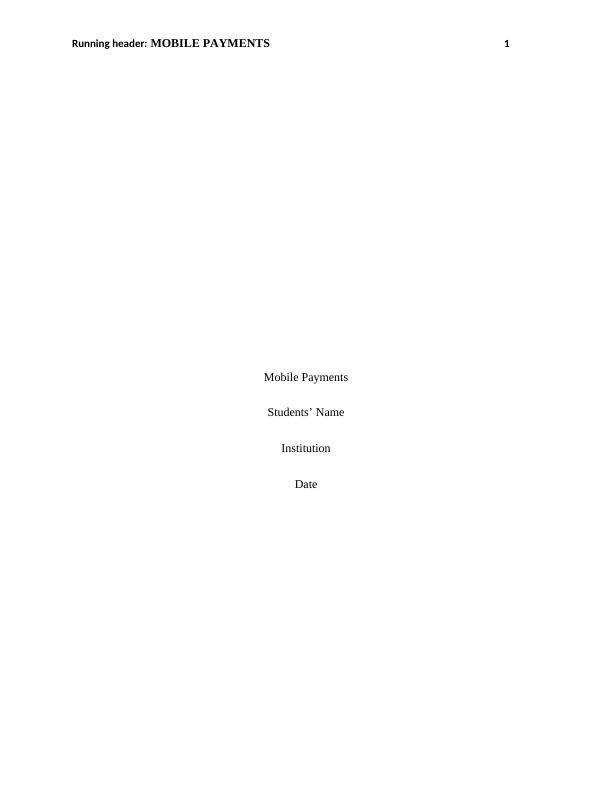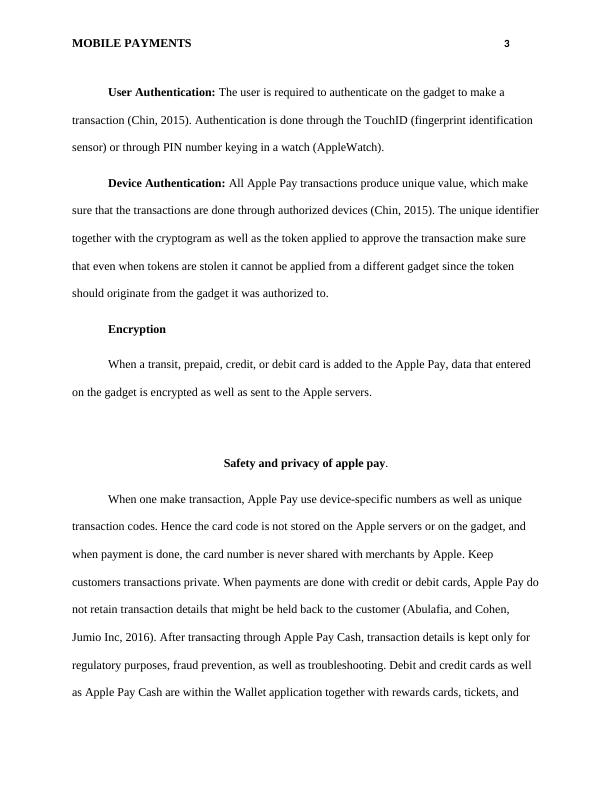Mobile Payments: A Comparison of Apple Pay and Google Pay
Added on 2023-06-12
9 Pages2153 Words431 Views
Running header: MOBILE PAYMENTS 1
Mobile Payments
Students’ Name
Institution
Date
Mobile Payments
Students’ Name
Institution
Date

MOBILE PAYMENTS 2
Introduction
Mobile payment which is also known as mobile wallet, mobile money transfer, as well as
mobile money, usually refer to transactions done under financial regulations and done via or
from a mobile gadget (Rackley III, Porter, Rickman, and Cochran, Qualcomm Inc, 2013). There
are several mobile money services that are currently available in existence, and the variances
among them might get murky and confusing. Mobile payment services are growing every year
and they are truly our future. This paper will look at Apple pay and Google pay, look at how
each of them works and the persons who are legible to use them.
Apple Pay
Apple Pay provides secure, confidential, and easy electronic transaction services using
iPad, iPhone, Mac, and Apple Watch. Other than Apple gadgets, what is required in addition is
the recent version of Apple's Wallet app, MacOS or watchOS, iOs, as well as Apple ID engaged
to iCloud. When one receives cash, it is directed to his/her Apple Pay money card that is found
within the Wallet application (https://www.business.com). It is easy to start using money
immediately after reception to purchase anything through Apple Pay in apps, in stores, as well as
through online. Apple Pay money balance can as well be to the owner’s bank account (Chin,
2015). After purchasing anything using Apple Pay, receipts are stored in Wallet apps, however
the transaction details are not kept elsewhere. Each transaction made through Mac, iPhone, and
iPad requires authentication through passwords, Face IDs, or Touch IDs. Unique passcode is
used to protect the Apple Watch.
Authentication
Introduction
Mobile payment which is also known as mobile wallet, mobile money transfer, as well as
mobile money, usually refer to transactions done under financial regulations and done via or
from a mobile gadget (Rackley III, Porter, Rickman, and Cochran, Qualcomm Inc, 2013). There
are several mobile money services that are currently available in existence, and the variances
among them might get murky and confusing. Mobile payment services are growing every year
and they are truly our future. This paper will look at Apple pay and Google pay, look at how
each of them works and the persons who are legible to use them.
Apple Pay
Apple Pay provides secure, confidential, and easy electronic transaction services using
iPad, iPhone, Mac, and Apple Watch. Other than Apple gadgets, what is required in addition is
the recent version of Apple's Wallet app, MacOS or watchOS, iOs, as well as Apple ID engaged
to iCloud. When one receives cash, it is directed to his/her Apple Pay money card that is found
within the Wallet application (https://www.business.com). It is easy to start using money
immediately after reception to purchase anything through Apple Pay in apps, in stores, as well as
through online. Apple Pay money balance can as well be to the owner’s bank account (Chin,
2015). After purchasing anything using Apple Pay, receipts are stored in Wallet apps, however
the transaction details are not kept elsewhere. Each transaction made through Mac, iPhone, and
iPad requires authentication through passwords, Face IDs, or Touch IDs. Unique passcode is
used to protect the Apple Watch.
Authentication

MOBILE PAYMENTS 3
User Authentication: The user is required to authenticate on the gadget to make a
transaction (Chin, 2015). Authentication is done through the TouchID (fingerprint identification
sensor) or through PIN number keying in a watch (AppleWatch).
Device Authentication: All Apple Pay transactions produce unique value, which make
sure that the transactions are done through authorized devices (Chin, 2015). The unique identifier
together with the cryptogram as well as the token applied to approve the transaction make sure
that even when tokens are stolen it cannot be applied from a different gadget since the token
should originate from the gadget it was authorized to.
Encryption
When a transit, prepaid, credit, or debit card is added to the Apple Pay, data that entered
on the gadget is encrypted as well as sent to the Apple servers.
Safety and privacy of apple pay.
When one make transaction, Apple Pay use device-specific numbers as well as unique
transaction codes. Hence the card code is not stored on the Apple servers or on the gadget, and
when payment is done, the card number is never shared with merchants by Apple. Keep
customers transactions private. When payments are done with credit or debit cards, Apple Pay do
not retain transaction details that might be held back to the customer (Abulafia, and Cohen,
Jumio Inc, 2016). After transacting through Apple Pay Cash, transaction details is kept only for
regulatory purposes, fraud prevention, as well as troubleshooting. Debit and credit cards as well
as Apple Pay Cash are within the Wallet application together with rewards cards, tickets, and
User Authentication: The user is required to authenticate on the gadget to make a
transaction (Chin, 2015). Authentication is done through the TouchID (fingerprint identification
sensor) or through PIN number keying in a watch (AppleWatch).
Device Authentication: All Apple Pay transactions produce unique value, which make
sure that the transactions are done through authorized devices (Chin, 2015). The unique identifier
together with the cryptogram as well as the token applied to approve the transaction make sure
that even when tokens are stolen it cannot be applied from a different gadget since the token
should originate from the gadget it was authorized to.
Encryption
When a transit, prepaid, credit, or debit card is added to the Apple Pay, data that entered
on the gadget is encrypted as well as sent to the Apple servers.
Safety and privacy of apple pay.
When one make transaction, Apple Pay use device-specific numbers as well as unique
transaction codes. Hence the card code is not stored on the Apple servers or on the gadget, and
when payment is done, the card number is never shared with merchants by Apple. Keep
customers transactions private. When payments are done with credit or debit cards, Apple Pay do
not retain transaction details that might be held back to the customer (Abulafia, and Cohen,
Jumio Inc, 2016). After transacting through Apple Pay Cash, transaction details is kept only for
regulatory purposes, fraud prevention, as well as troubleshooting. Debit and credit cards as well
as Apple Pay Cash are within the Wallet application together with rewards cards, tickets, and

End of preview
Want to access all the pages? Upload your documents or become a member.
Related Documents
Apple Announces Apple Pay - Apple (UK)lg...
|3
|1290
|483
A Literature Review on Mobile Paymentlg...
|11
|648
|35
Apple Pay: A Secure and Convenient Payment Systemlg...
|33
|1072
|58
E-Commerce Assignment: Innovation in Mobilelg...
|11
|2843
|292
Analysis of Mobile Payment Market: Value Propositions, Limitations, and Strategieslg...
|7
|1405
|403
